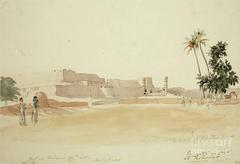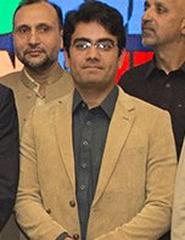Comprehensive Guide to Visiting Peshawar Museum, Peshawar, Pakistan
Date: 23/07/2024
Introduction
Discover the rich cultural heritage of Peshawar at the Peshawar Museum, a beacon of history and art since its establishment in 1907. Initially named Victoria Hall to honor Queen Victoria’s Golden Jubilee, this museum stands as an architectural marvel blending British, Mughal, and Sikh styles (Peshawar Museum - History, Tickets, and Must-See Exhibits). Located in the heart of Peshawar, Pakistan, it serves as a repository of the region’s diverse cultural and historical artifacts. The museum is particularly renowned for its extensive collection of Gandharan art, including the famous Fasting Buddha, making it a significant attraction for historians, archaeologists, and tourists alike (Peshawar Museum - Visiting Hours, Tickets, and Historical Significance). Whether you’re a history buff or a curious traveler, the Peshawar Museum offers an enriching experience that paints a vivid picture of the region’s past and its interactions with ancient civilizations.
Table of Contents
- Introduction
- History of Peshawar Museum
- Collection and Exhibits
- Expansion and Modernization
- Visitor Information
- Historical Significance
- Challenges and Preservation Efforts
- Visitor Experience
- Frequently Asked Questions (FAQ)
- Conclusion
History of Peshawar Museum
Establishment and Early Years
The Peshawar Museum, located in Peshawar, Pakistan, was established in 1907 during the British colonial period. Initially named the Victoria Hall, it was built to commemorate Queen Victoria’s Golden Jubilee. The museum’s construction was funded by the British government and local philanthropists, reflecting the colonial administration’s interest in preserving and showcasing the region’s rich cultural heritage. The building itself is an architectural marvel, combining British, Mughal, and Sikh styles, which is evident in its two-story structure with spacious halls and high ceilings.
Architectural Significance
The museum’s architecture is a blend of British colonial and Mughal styles, featuring red bricks and white stone. The main hall is adorned with intricate woodwork and decorative motifs that reflect the artistic traditions of the region. The building’s design not only serves as a repository for artifacts but also stands as a historical monument in its own right. The museum’s layout includes a central hall flanked by two side galleries, which were later expanded to accommodate the growing collection of artifacts.
Collection and Exhibits
Gandharan Art Collection
The Peshawar Museum is renowned for its extensive collection of Gandharan art, which dates back to the 1st to 5th centuries CE. The museum houses over 14,000 artifacts, including sculptures, coins, manuscripts, and weapons. The Gandharan sculptures are particularly noteworthy for their intricate carvings and detailed depictions of Buddhist themes. These artifacts provide invaluable insights into the region’s historical and cultural interactions with ancient civilizations, including Greece, Persia, and India.
One of the museum’s most significant exhibits is the Fasting Buddha, a rare and exquisite sculpture that depicts Siddhartha Gautama during his period of extreme asceticism. This piece is considered one of the finest examples of Gandharan art and attracts scholars and tourists from around the world.
Buddhist Relics
The Peshawar Museum is home to an impressive array of Buddhist relics, including stupas, statues, and friezes. These artifacts are crucial for understanding the spread of Buddhism in the region. The museum’s collection includes relics from the famous Kanishka stupa, which was one of the tallest buildings in the ancient world. The presence of these relics underscores Peshawar’s historical role as a major center of Buddhist learning and pilgrimage.
Ethnographic Exhibits
In addition to its Gandharan collection, the Peshawar Museum also features ethnographic exhibits that showcase the diverse cultures of the Khyber Pakhtunkhwa province. These exhibits include traditional clothing, jewelry, weapons, and household items from various ethnic groups such as the Pashtuns, Kalash, and Kohistanis. These displays provide a comprehensive overview of the region’s cultural diversity and offer visitors a glimpse into the daily lives and traditions of its inhabitants.
Islamic Art and Manuscripts
The museum also boasts a significant collection of Islamic art and manuscripts. These include intricately designed Quranic manuscripts, calligraphy, and miniature paintings from the Mughal and Persian periods. The Islamic art section highlights the region’s rich Islamic heritage and its contributions to the broader Islamic world. Notable pieces include a rare 11th-century Quranic manuscript and exquisite examples of Mughal miniature paintings.
Expansion and Modernization
Over the years, the Peshawar Museum has undergone several expansions and renovations to accommodate its growing collection and to enhance the visitor experience. In the 1960s, additional galleries were added to display Islamic art, ethnographic artifacts, and contemporary works. The museum also features a dedicated section for the region’s rich Islamic heritage, showcasing manuscripts, calligraphy, and architectural fragments from various historical periods.
In recent years, the museum has embraced modern technology to improve its exhibits and educational programs. Interactive displays, digital archives, and multimedia presentations have been introduced to engage visitors and provide a more immersive experience. These efforts have been supported by both the Pakistani government and international organizations, reflecting a broader commitment to preserving and promoting the region’s cultural heritage.
Visitor Information
Visiting Hours
The Peshawar Museum is open to visitors from 9:00 AM to 4:00 PM, Monday through Saturday. The museum is closed on Sundays and public holidays.
Tickets
- Adults: PKR 20
- Children: PKR 10
- Foreigners: PKR 200
Tickets can be purchased at the entrance. Group discounts are available for school and college students.
Travel Tips
- Best Time to Visit: The best time to visit the museum is in the cooler months from October to March to avoid the extreme summer heat.
- Photography: Photography is allowed inside the museum, but flash photography is prohibited to protect the artifacts.
- Guided Tours: The museum offers guided tours in multiple languages, including English and Urdu, providing in-depth information about the exhibits.
Nearby Attractions
- Bala Hisar Fort: A historical fort offering panoramic views of Peshawar city.
- Sethi House Museum: A beautifully preserved example of traditional Peshawar architecture.
- Qissa Khwani Bazaar: A bustling market known for its vibrant atmosphere and historical significance.
Historical Significance
The Peshawar Museum holds immense historical significance, not only for its collection but also for its role in preserving the cultural heritage of the region. The museum’s artifacts provide a tangible link to the past, offering insights into the social, religious, and artistic developments that have shaped the region over millennia. The museum also serves as a center for research and scholarship, attracting historians, archaeologists, and art historians from around the world.
The museum’s collection of Gandharan art is particularly significant, as it represents a unique fusion of Greco-Roman and Indian artistic traditions. This cultural synthesis is a testament to the region’s historical role as a crossroads of civilizations, where diverse cultures and ideas have intersected and influenced one another.
Challenges and Preservation Efforts
Despite its historical and cultural significance, the Peshawar Museum faces several challenges, including limited funding, security concerns, and the need for ongoing conservation efforts. The museum’s management has been proactive in addressing these issues, seeking support from both governmental and non-governmental organizations to ensure the preservation of its invaluable collection.
In recent years, there have been concerted efforts to enhance the museum’s security and to implement modern conservation techniques. These initiatives are crucial for safeguarding the museum’s artifacts and for ensuring that future generations can continue to learn from and appreciate the region’s rich cultural heritage.
Visitor Experience
The Peshawar Museum offers a unique and enriching experience for visitors, providing a window into the region’s diverse and multifaceted history. The museum’s well-curated exhibits and informative displays make it an essential destination for anyone interested in the cultural heritage of Pakistan and the broader South Asian region.
Visitors can explore the museum’s various galleries at their own pace, with informative plaques and interactive displays providing context and background information. The museum also offers guided tours, educational programs, and special exhibitions, making it a dynamic and engaging institution.
Frequently Asked Questions (FAQ)
Q: What are the visiting hours of Peshawar Museum?
A: The Peshawar Museum is open from 9:00 AM to 4:00 PM, Monday through Saturday, and is closed on Sundays and public holidays.
Q: How much are the tickets for Peshawar Museum?
A: Adults: PKR 20, Children: PKR 10, Foreigners: PKR 200.
Q: Are guided tours available?
A: Yes, the museum offers guided tours in multiple languages, including English and Urdu.
Q: Can I take photographs inside the museum?
A: Photography is allowed, but flash photography is prohibited to protect the artifacts.
Conclusion
The Peshawar Museum stands as a testament to the rich cultural and historical tapestry of the Gandhara region. Its vast collection, ranging from Gandharan sculptures to Islamic manuscripts, provides invaluable insights into the region’s diverse historical epochs and cultural exchanges. Despite facing challenges such as limited funding and the need for ongoing conservation, the museum has made significant strides in modernizing its exhibits and enhancing visitor engagement through interactive displays and educational programs (Visitor Tips for Peshawar Museum - Hours, Tickets, and Nearby Attractions). The Peshawar Museum not only serves as a crucial center for research and scholarship but also as a cultural landmark that continues to attract and educate visitors from around the world. As efforts to preserve and promote this cultural heritage continue, the museum remains a vital link to understanding the complex history and cultural evolution of the region.
References
- Visiting Peshawar Museum - History, Tickets, and Must-See Exhibits, 2024 http://www.kp.gov.pk/page/peshawar_museum
- Peshawar Museum - Visiting Hours, Tickets, and Historical Significance, 2024 http://www.peshawarmuseum.gov.pk
- Visitor Tips for Peshawar Museum - Hours, Tickets, and Nearby Attractions, 2024 http://www.kp.gov.pk/page/peshawar_museum




